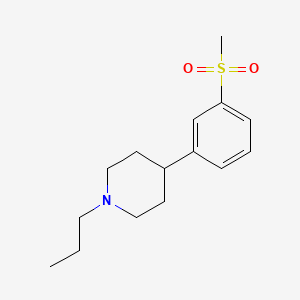
Synopsis
Synopsis
0
API Suppliers
0
USDMF
0
CEP/COS
0
JDMF
0
EU WC
0
KDMF
0
NDC API
0
VMF
0
Listed Suppliers
0
EDQM
0
USP
0
JP
0
Others
0
FDF Dossiers
0
FDA Orange Book

0
Europe

0
Canada

0
Australia

0
South Africa

0
Listed Dossiers
DRUG PRODUCT COMPOSITIONS
0
US Patents
0
US Exclusivities
0
Health Canada Patents
US Medicaid
NA
Annual Reports
NA
Regulatory FDF Prices
NA
0
API
0
FDF
0
Data Compilation #PharmaFlow
0
Stock Recap #PipelineProspector
0
Weekly News Recap #Phispers


1. 4-(3-(methylsulfonyl)phenyl)-1-propylpiperidine
2. 4-(3-methanesulfonylphenyl)-1-propylpiperidine
3. Acr16 Compound
4. Huntexil
1. 346688-38-8
2. 4-[3-(methylsulfonyl)phenyl]-1-propylpiperidine
3. 4-(3-(methylsulfonyl)phenyl)-1-propylpiperidine
4. Acr16
5. Acr-16
6. 4-(3-methylsulfonylphenyl)-1-propylpiperidine
7. Hd4tw8s2vk
8. Chembl596802
9. Fr310826
10. Unii-hd4tw8s2vk
11. Acr16 Compound
12. Acr 16
13. Pridopidine [usan]
14. Pridopidine [usan:inn]
15. Pridopidine [mi]
16. Pridopidine [inn]
17. Pridopidine (usan/inn)
18. 4-(3-methanesulfonyl-phenyl)-1-propyl-piperidine
19. Pridopidine [who-dd]
20. Schembl166748
21. Asp2314
22. Dtxsid90188225
23. Bdbm50308028
24. Mfcd09835586
25. Zinc22063703
26. Akos015891431
27. Db11947
28. Ncgc00386586-01
29. As-50146
30. Hy-10684
31. Db-014417
32. Cs-0002733
33. Ft-0672149
34. 4-(3-methanesulfonylphenyl)-1-propylpiperidine
35. D09953
36. O11067
37. Q7242858
38. Piperidine, 4-(3-(methylsulfonyl)phenyl)-1-propyl-
| Molecular Weight | 281.4 g/mol |
|---|---|
| Molecular Formula | C15H23NO2S |
| XLogP3 | 2.6 |
| Hydrogen Bond Donor Count | 0 |
| Hydrogen Bond Acceptor Count | 3 |
| Rotatable Bond Count | 4 |
| Exact Mass | 281.14495015 g/mol |
| Monoisotopic Mass | 281.14495015 g/mol |
| Topological Polar Surface Area | 45.8 Ų |
| Heavy Atom Count | 19 |
| Formal Charge | 0 |
| Complexity | 366 |
| Isotope Atom Count | 0 |
| Defined Atom Stereocenter Count | 0 |
| Undefined Atom Stereocenter Count | 0 |
| Defined Bond Stereocenter Count | 0 |
| Undefined Bond Stereocenter Count | 0 |
| Covalently Bonded Unit Count | 1 |
Investigated for use/treatment in huntington's disease and schizophrenia and schizoaffective disorders.
ACR16 belongs to a novel class of drugs, characterised as dopaminergic stabilisers, CNS active compounds that can both enhance and counteract dopaminergic effects in the brain depending on the initial level of dopaminergic activity. ARC16 works to "smooth" the many functions of this neurotransmitter chemical in striatum and other areas of the brain. Thus they have the ability to stabilize behavioural and motor disturbances caused by neurological and psychiatric disorders. They do this in pathological states without compromising normal thought processes or motor functions.
ABOUT THIS PAGE
73
PharmaCompass offers a list of Pridopidine API manufacturers, exporters & distributors, which can be sorted by GMP, USDMF, JDMF, KDMF, CEP (COS), WC, Price,and more, enabling you to easily find the right Pridopidine manufacturer or Pridopidine supplier for your needs.
Send us enquiries for free, and we will assist you in establishing a direct connection with your preferred Pridopidine manufacturer or Pridopidine supplier.
PharmaCompass also assists you with knowing the Pridopidine API Price utilized in the formulation of products. Pridopidine API Price is not always fixed or binding as the Pridopidine Price is obtained through a variety of data sources. The Pridopidine Price can also vary due to multiple factors, including market conditions, regulatory modifications, or negotiated pricing deals.
A Pridopidine manufacturer is defined as any person or entity involved in the manufacture, preparation, processing, compounding or propagation of Pridopidine, including repackagers and relabelers. The FDA regulates Pridopidine manufacturers to ensure that their products comply with relevant laws and regulations and are safe and effective to use. Pridopidine API Manufacturers are required to adhere to Good Manufacturing Practices (GMP) to ensure that their products are consistently manufactured to meet established quality criteria.
A Pridopidine supplier is an individual or a company that provides Pridopidine active pharmaceutical ingredient (API) or Pridopidine finished formulations upon request. The Pridopidine suppliers may include Pridopidine API manufacturers, exporters, distributors and traders.
Pridopidine Active pharmaceutical ingredient (API) is produced in GMP-certified manufacturing facility.
GMP stands for Good Manufacturing Practices, which is a system used in the pharmaceutical industry to make sure that goods are regularly produced and monitored in accordance with quality standards. The FDA’s current Good Manufacturing Practices requirements are referred to as cGMP or current GMP which indicates that the company follows the most recent GMP specifications. The World Health Organization (WHO) has its own set of GMP guidelines, called the WHO GMP. Different countries can also set their own guidelines for GMP like China (Chinese GMP) or the EU (EU GMP).
PharmaCompass offers a list of Pridopidine GMP manufacturers, exporters & distributors, which can be sorted by USDMF, JDMF, KDMF, CEP (COS), WC, API price, and more, enabling you to easily find the right Pridopidine GMP manufacturer or Pridopidine GMP API supplier for your needs.
A Pridopidine CoA (Certificate of Analysis) is a formal document that attests to Pridopidine's compliance with Pridopidine specifications and serves as a tool for batch-level quality control.
Pridopidine CoA mostly includes findings from lab analyses of a specific batch. For each Pridopidine CoA document that a company creates, the USFDA specifies specific requirements, such as supplier information, material identification, transportation data, evidence of conformity and signature data.
Pridopidine may be tested according to a variety of international standards, such as European Pharmacopoeia (Pridopidine EP), Pridopidine JP (Japanese Pharmacopeia) and the US Pharmacopoeia (Pridopidine USP).
